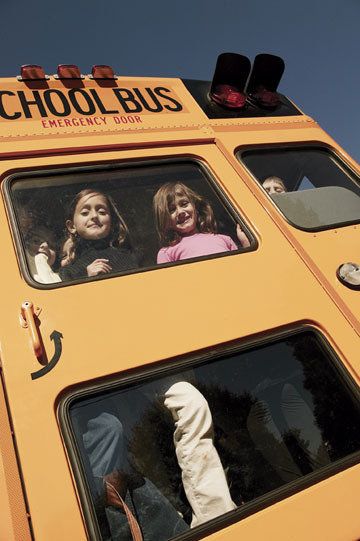
In my recent post, Race to the Top?: Part I, I described the academic achievement rat race in which students near the top of the educational food chain strive maniacally to win (or at least finish). I argued that the emphasis on testing by former President Bush's No Child Left Behind law (NCLB) and continued with President Obama's Race to the Top initiative (RTTT) has only exacerbated the problem better characterized by the title of the powerful new documentary by Vicki Abeles, Race to Nowhere. This post, in contrast, explores how RTTT impacts those students and schools at the other end of the educational food chain, those who are just trying to survive in the turbulent sea of American public education.
The first mistake that this administration made was to call education reform a race. Races connote winners and losers. Yet, we need to ensure that all our students and schools are winners. I think a more appropriate name for this initiative is "Climb to the Top" because the focus should be on how to get to the top.
The administration's second mistake was to continue Bush's initial mistake of focusing on testing; instead of being a tool for education reform, testing has morphed into the end-all, be-all of said reform. Yes, assessment is essential for determining the effectiveness of programs such as RTTT, aimed at achieving something as ethereal and elusive as education reform or the more tangible goal of closing the education and economic gaps between the haves and have-nots. At the same time, improved test scores should not be the ultimate objective of education reform.
This notion that test results are the essential goal of education reform has created an environment in which teachers must "teach to the test;" students aren't really educated so much as prepared to pass tests so schools and states can get federal funding. School administrators hate teaching to the test because schools become fact factories instead of houses of learning. Teachers hate it because they are forced into a very small curricular box and are not allowed to do what they love to do, namely, educate young people. And students hate it because rote memorization of facts is neither interesting nor motivating, and they don't get a real education. Perhaps the saddest aspect of NCLB is that it hasn't worked! In the eight plus years in which NCLB has been in place, there have been few appreciable or lasting gains in test scores for which NCLB can take credit. What it has overwhelmingly succeeded at is driving schools and states to game the system (i.e., lower standards, cherry-pick data) to keep the federal-funding spigot flowing. RTTT changes some parameters, but the same philosophy and methodology persist. When we continue down this road, we are validating the well-known Law of Insanity: doing the same thing over and over and expecting different results.
A third mistake our government has made is to allow improving test scores to supersede actually educating our children. For example, in a recent New Yorker article profiling the new U.S. Secretary of Education Arne Duncan, the Department of Education mandates that states must fulfill "four assurances" to receive federal stimulus money: "progress in raising standards, in recruiting and retaining effective teachers, in tracking students' and teachers' performance, and in turning around failing schools." Only one, the recruitment and retention of effective teachers, is a goal that directly impacts the quality of education. The first and last are simply amorphous outcomes that will hopefully result from reform. And the third goal is simply a measurement procedure that may or may not be useful in assessing the effectiveness of the reform. Though these criteria may be useful, they are far afield of what of takes to truly improve the quality of education that our children receive in public schools. These "assurances" also obscure the real steps that must be taken to catalyze significant education reform and gloss over the meaningful results of actually educating our children.
What I find so maddening about RTTT is the absence of any discussion of meaningful process or outcome goals. Tests results aren't an outcome, they are a measure of outcome. What should the real outcome goals be? To answer that question, we need to gaze into the future with our crystal balls and figure out what knowledge and skill sets young people will need to play a vital role in our country's future. Obviously, they must have the basics, the 3 Rs. But those basics will only get our next generation so far in a world that grows increasingly complex by the year. Today's young people need be capable of thinking critically, being creative, consistent effort, patience and perseverance, performing under pressure, and working effectively as a group, among others. And, just as importantly, our education system must produce well-informed citizens capable of participating actively in our democracy.
With those clear outcome goals in place, it's now possible to create a set of process goals to achieve those outcome goals. Here's a few for starters: build family, community, and school cultures in which interest in learning and educational aspirations are the norm; create home and school environments that support and encourage learning; instill a love of and motivation to learn; meet the individual needs of students; and teach good life skills and study habits.
With those process goals identified, we can develop a set of procedures to achieve the process goals which will then fulfill the outcome goals. There is actually good evidence for what some of those procedures are. One of the most robust findings, not surprisingly, is competent teachers. Small class sizes give those capable teachers the chance to really connect with and impact their students. Though I haven't seen any data on this, I would assume a safe school environment is essential to learning. And perhaps the most important, and daunting, contributor is an early home environment that provides positive role models, rich verbal interaction, consistent exposure to reading, and opportunities to learn essential life skills such as goal setting, self-discipline, and time management, all of which will serve young people well as they progress through school.
Arne Duncan has a very big carrot, about seventy billion dollars, with which to motivate states, schools, educators, parents, and students to reform our public-education system. But incentive without the means to harness that motivation is akin to wanting to drive somewhere, but not having a map or even a destination. And RTTT offers neither.
Secretary Duncan would be wise to read a recent commentary in the New York Times by Susan Engel. In the piece, Dr. Engel advocates an overhaul of the educational curriculum itself that is based on our scientific understanding of child development and effective teaching practices. The focus should be on what and how children learn, not on what and how they can pass a test. As she suggests, we need to develop "a curriculum designed to raise children rather than test scores."
Billions upon billions of dollars have been spent over many decades in the name of education reform with nothing appreciable to show for it. Remember the Law of Insanity? Secretary Duncan has an historic opportunity to spearhead real education reform. So, yes, spend the money, but, far more importantly, give educators what they need so we will finally get the real results for which we have been waiting for so long: educated children capable of working toward and achieving the American Dream.
